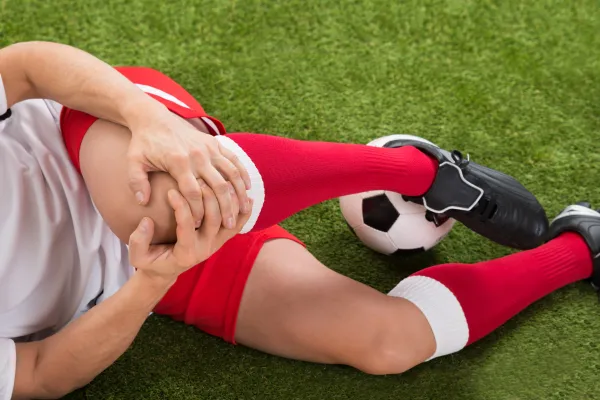Get Ready to Code for Knee Injuries

Here’s What You Must Know to Embrace ICD-10 System of Coding
Increased emphasis on physical fitness has made knee injuries common not only among athletes but also among the general population, Arthroscopy has become one of the most frequently used procedures for diagnosis and treatment of knee injuries. As you know, this surgical procedure is often done as an outpatient. So as an outpatient coder, it is good idea to know the anatomy of specific sites, and the new framework of the codes for different diagnoses and procedures, that will make your life simpler
Read on to know how the codes in the new system expand to include laterality, encounters, and types of fracture making the codes more specific and informative.
Starting point: In ICD-10-CM, codes for injuries to the knee and lower leg run from S80.- to S89.-. The codes are categorized by the anatomic site (such as patella or meniscus) rather than the type of injury.
Pay Attention to These 3 Anatomic Sites
Site 1: The Patella
The patella, also known as the knee cap, is connected by ligaments and tendons to the femur (thighbone).
The increased specificity available in ICD-10-CM is seen with the wide breadth of codes available to code for fractures of the patella, which begin at S82.0 (Fracture of patella). Your coding choices will include:
Each entry expands to report laterality (left or right). If the physician does not specify the side, you’ll report a code for an unspecified leg. Many entries also allow you to code for a displaced or nondisplaced fracture. If the physician does not specify, coders will default to “displaced.”
For example:
Fracture note: Most codes for knee fractures also require a seventh character. These characters allow coders to report more specific information about the encounter, and whether the fracture was closed or open, for example, S82.001A (Unspecified fracture of right patella,initial encounter for closed fracture). This is done along with its classification using the Gustilo-Anderson scale. The Gustilo-Anderson classification system remains the preferred system for categorizing open fractures and it correlates well with the risk of infection and other complications. Refer to the source (http://www.ncbi.nlm.nih.gov/pmc/articles/PMC3462875/) for more information.
Site 2: Menisci
Movement in the knee joint is aided by menisci, which lie in between the tibia (shinbone) and the bottom of the femur. The medial and lateral menisci are crescent-shaped discs made of fibro cartilage that provide cushioning for the knee joint. They also allow the complex movements of the knee joint.
ICD-10-CM offers extensive coding options for tears to the meniscus, allowing coders to specify the type of tear, which meniscus was impacted, and on which leg the tear occurred. You’ll find these codes in the S83- series (Dislocation and sprain of joints and ligaments of knee). As with the knee fracture codes, guidelines at the beginning of S83- state that one of the following must be added to codes in that category as the seventh character:
A, Initial encounter
o S83.30, Tear of articular cartilage of unspecified knee, current
o S83.31XA, … initial encounter
o S83.32XA, … initial encounter
Don’t miss: The S83.3 codes only contain five characters, so coders will insert the placeholder “X” as the sixth character before adding the seventh character (A, D, or S) to complete the code. For example, the code for the initial encounter for a tear in the articular cartilage of the right knee would be S83.31XA.
Also note that the S83.3- codes apply to a new, or current, cartilage tear, even if the visit is for a subsequent encounter (when a physician treats a patient for the same injury during the healing or recovery phase).
When you code for derangement of old injuries to the knee, you’ll turn to sections M20.- to M25.- (Other joint disorders…). For example, you’ll use a code from the M23.21 series for derangement of the anterior horn of medial meniscus due to old tear or injury:
Site 3: Bursae
Bursae are pockets of synovial fluid that help lubricate tendons around the knee joint. Three important groups of bursae are located in the knee. Those are:
Diagnoses for bursitis and specific afflictions affecting the bursae in the knee are located in the M71.- series in ICD-10-CM. All codes in this category require coders to report laterality or an unspecified side.
Additionally, the guidelines state that for M71.0 (Abscess of bursa) and M71.1 (Other infective bursitis), coders must use an additional code from series B95.- (Streptococcus, Staphylococcus, and Enterococcus as the cause of diseases classified elsewhere) or B96.- (Other bacterial agents as the cause of diseases classified elsewhere) to identify the causative organism.
Both series also include the following Excludes1 notes:
D, Subsequent encounter
S, Sequela.
o S83.30XA, … initial encounter
o S83.30XD, … subsequent encounter
o S83.30XS, … sequela
o S83.31XD, … subsequent encounter
o S83.31XS, …… sequela
o S83.32XD, … subsequent encounter
o S83.32XS, … sequela

